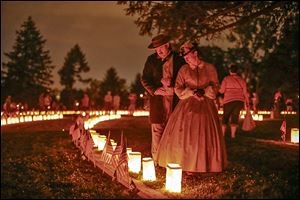
GETTYSBURG VISITORS MARK DAY 1 OF KEY BATTLE
Seminary Ridge museum offers its view of Civil War
7/2/2013
Re-enactors stand near luminaries that mark the graves of Union dead at Soldiers’ National Cemetery in Gettysburg, Pa. On July 1, 1863, Union cavalry slowed down the Confederates’ advance.
GETTYSBURG, Pa. — Connecticut resident George Sipprell stood in the rooftop cupola of the new Seminary Ridge Museum and gazed out on the breathtaking view of the hilly terrain where Northerners fought Southerners on July 1, 1863, exactly 150 years ago Monday.
“The view is spectacular,” said Mr. Sipprell, who was with friends. “We are just ecstatic.”
He learned more than a year ago that the Seminary Ridge Historic Preservation Foundation, working with the Adams County Historical Society and Evangelical Lutheran officials, had decided to renovate the old red-brick, four-story seminary building, which was erected in 1832.
The project was intended to educate Americans about the battle and honor soldiers from both sides who fought, were wounded, and died on the first day of the three-day clash that changed the course of the Civil War.
Mr. Sipprell sought reservations from Seminary Ridge officials in early 2012, hoping to be among the first to climb the narrow wooden staircase from the fourth floor of the old seminary into the cupola, which only holds a dozen or so people at a time.
He got his wish. He and his friends were the very first visitors to enter the cupola, where Union Gen. John Buford, on the morning of July 1, 1863, saw Confederate troops streaming from the west toward Gettysburg.
He ordered his badly outnumbered cavalry troops to dismount and block the Confederates, putting up such a fight that it took the attackers nearly all day to capture Seminary Ridge, a hill just west of town and where the Lutheran Seminary still sits.
General Buford also ordered Union cannons to fire at the enemy. So on Monday five groups of blue-uniformed Union re-enactors loaded five Civil War cannons. At 8 a.m. they fired 25 deafening blasts, with smoke pouring from each barrel as each round went off. Several hundred visitors watched and cheered.
The museum has dozens of rooms devoted to Civil War soldiers, the fight against slavery and other issues of the 1860s, medical care, and details of the July 1 fighting.
Houston businessman David H. LaCook was among the speakers, along with Pennsylvania Gov. Tom Corbett and U.S. Sen. Pat Toomey, who addressed the several thousand people.
Mr. LaCook gave an oversized check for $150,000 to Seminary Ridge Museum officials, a private donation from his firm, FabEnCo Founding Fathers Foundation.
It was just one part of the $15 million in funds from federal and state governments, private foundations and individuals, and bond money used during the last year to repair and update the seminary classroom building, including adding new heating, electrical, and ventilation systems.
Several visitors said the cupola provides a 360-degree view of Gettysburg — from where the Confederates advanced from the west, to the downtown less than a mile away to the east, and even the area southeast of town where Union forces massed on Cemetery Ridge and fought off the enemy the rest of the battle.
The seminary became a field hospital, and it remained one until September, 1863. In July, 1863, the building was called Schmucker Hall, after seminary president Samuel Schmucker, a Lutheran pastor. His house still stands a couple hundred yards down the road.
The building was put on the National Register of Historic Places in 1973.
The Block News Alliance consists of The Blade and the Pittsburgh Post-Gazette.